Judenrampe
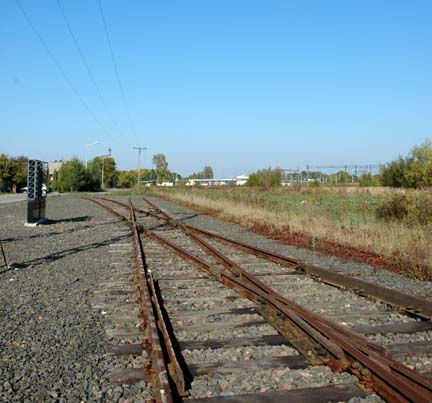
Railroad siding near
Birkenau where the Jews disembarked from trains
In 1942, a wooden ramp was built at Auschwitz,
next to a railroad siding that split off from the main railroad
line, which ran from Krakow to Vienna. This was the Judenrampe,
where the Jews who were brought to Auschwitz-Birkenau, disembarked
from cattle cars on freight trains carrying from 2,000 to 3,000
people. The photo above shows the railroad siding. The wooden
ramp is now gone.
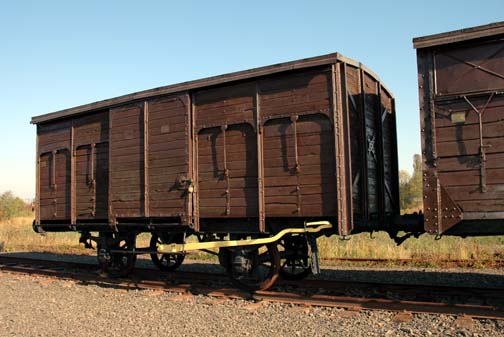 Cattle car used to
transport Jews to Auschwitz-Birkenau
Cattle car used to
transport Jews to Auschwitz-Birkenau
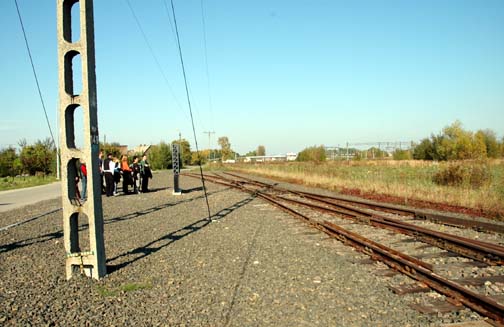
Railroad siding where
Jews disembarked from trains
The location of the Judenrampe became
an official Memorial Site in early 2005 when 5 markers were set
up along the tracks, including one in honor of the French Jews
who were sent to Birkenau. Between February 1942 and the end
of April 1944, when the railroad tracks were extended inside
the Birkenau camp, there were approximately 500,000 Jews who
arrived at this ramp. According to the Auschwitz Museum, at least
75% of them were immediately gassed.
In the photo above, a tour group reads
the sign placed at this location, called the Judenrampe, where
the Jews arrived by train to be gassed at Birkenau before the
tracks were extended inside the camp in 1944. The photo below
shows the sign beside the tracks.

Sign in three languages
at the Judenrampe
Note the drawing on the sign in the photo
above. It shows the gate house at Birkenau, as it looked in 1943,
before the building was extended on both sides.
The Judenrampe was used from February
1942 until the first of May 1944. At the end of April 1944, the
extermination of the Jews from Hungary began. By that time, a
railroad spur line had been extended inside the camp, all the
way to the gas chambers in Krema II and Krema III.
One of the first prisoners to arrive
at the ramp was Philip Riteman who told a group of students
at Annapolis Regional Academy in Nova Scotia in May 2007 the
following about his trip to Auschwtz-Birkeanu:
After a week, the train comes to a
stop along a huge platform, a mile long and four to five hundred
feet wide.
"I see a big sign 'Work makes
you free.' Auschwitz-Birkenau. I never heard of it. I didn't
know even of its existing."
The full article about Riteman's talk
to the students is on this web site.
Riteman overestimated the size of the
platform, which was actually about 500 yards long and 3 to 4
yards wide, according to the Auschwitz Museum. In another speech
to another group of students, Riteman said that the platform
was made of concrete. The ramp was near the main Auschwitz camp,
but the sign over the gate that reads "Arbeit Macht Frei"
was not visible from the ramp. Riteman told another group of
students that the words "Arbeit Macht Frei" were on
signs held by Auschwitz inmates at the ramp.
The photo below shows two original boxcars
used to transport the Jews to their death. The railroad tracks
are now overgrown with weeds. When I visited this site in October
2005, there was a new house under construction right across from
the tracks. Farther down the tracks is a series of factory buildings
that have been abandoned.
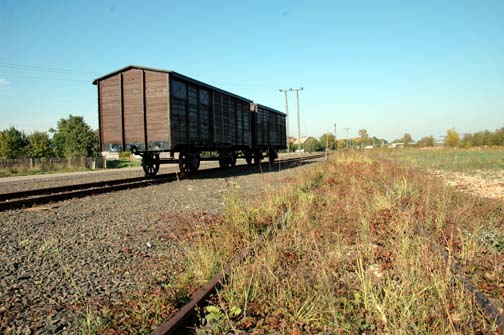 Original box cars used
to bring Jews to the gas chambers at Birkenau
Original box cars used
to bring Jews to the gas chambers at Birkenau
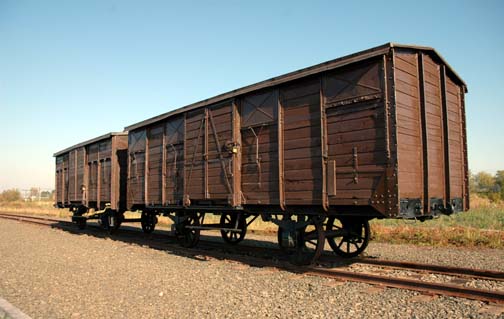
Two original box cars
at the Judenrampe
The trains bringing the Jews to Auschwitz-Birkenau
were made up of 50 cattle cars, each of which held 60 to 100
Jews, depending on the size of the car. A few passenger trains
arrived, carrying the VIP prisoners, but 90% of the victims arrived
in cattle cars.
When a train arrived, the SS men unlocked
the cars and barked at the passengers to get out quickly. They
were ordered to form two lines, one line of men and the other
line of women and children. Then each line passed in front of
SS officers, who stood on the ramp, resplendent in their black
SS dress uniforms. Men and women who were young, healthy, and
able to work, were waved to the right, while the old, the sick
and the children were waved to the left.
Dr. Josef Mengele, who arrived at Birkenau
in May 1943, was one of the SS men who selected the prisoners
for the gas chamber.
This selection process would take around
two hours. Then the able-bodied prisoners would be marched off
to the Auschwitz I camp where they would be registered.
After the chosen few were out of sight,
the group on the left, who were not considered fit for work,
were forced to climb a set of removable stairs into the open
bed of a dump truck, crowding 100 people into each one. The trucks
would then drive to the Birkenau camp and quickly return for
another load of victims.
The dead, the dying and the invalids
were then removed from the cattle cars and thrown onto a dump
truck, all jumbled together. Then a group of prisoners would
enter the empty cars and remove the luggage. Before the Sauna
building with its disinfection chambers was built in 1943 at
Birkenau, the luggage went to the main Auschwitz camp where it
was sorted and deloused in 19 disinfection chambers in the administration
building.
Rudolf Vrba was a Slovakian Jew who was
one of the first to arrive at Auschwitz. He was assigned to work
on the Judenrampe, removing the luggage from the trains; this
job allowed him to estimate the number of Jews who were being
gassed immediately upon arrival. Along with another inmate, Alfred
Wetzler, he escaped from the Birkenau camp in April 1944, just
before the Hungarian Jews were scheduled to be deported to their
deaths in the gas chambers. His report about the gas chambers
at the Auschwitz-Birkenau death camp was the first to reach the
Allies.
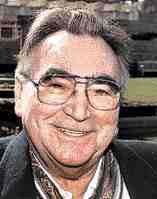 Rudolf Vrba - born
11 Sept. 1924, died 27 March 2006
Rudolf Vrba - born
11 Sept. 1924, died 27 March 2006
Before the four large gas chambers in
Krema II, Krema III, Krema IV and Krema V were put into use in
the Spring and Summer of 1943, the Jews were gassed in two old
farm houses located just outside the Birkenau camp. The Jews
that weren't gassed immediately lived in the barracks at Birkenau
and waited for further selections, which were made periodically.
According to the Auschwitz Museum, there were 100,000 prisoners
still alive in Birkenau in May 1944 when this ramp ceased to
be used.
Across from the railroad tracks are some
abandoned buildings near the Judenrampe, which are shown in the
photo below.
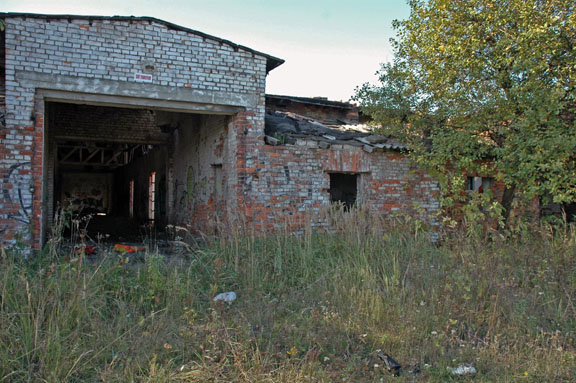 Abandoned buildings
across from the Judenrampe tracks, Oct. 2005
Abandoned buildings
across from the Judenrampe tracks, Oct. 2005
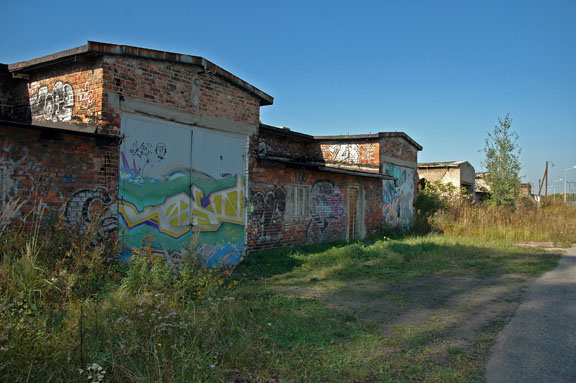 Old buildings across
from the Judenrampe tracks, Oct. 2005
Old buildings across
from the Judenrampe tracks, Oct. 2005
This page was last updated on June 1,
2009
|